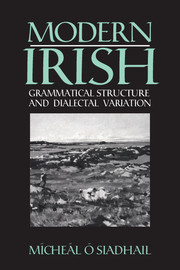Summary
The noun is discussed in this chapter under three headings, Gender (see Ó Siadhail 1984b:173-7), Inflection and Formation of the plural. While gender, case and number are distinct features, sections 7.1-7.3 also show that they are also inextricably interconnected.
Gender
Single gender
Parallels are often drawn between the relationship of natural time to tense and that of biological sex to gender. Despite some obvious exceptions such as stail (fem.) ‘stallion’ and cailín (masc.) ‘girl’, where morphological patterns override biological distinctions, Irish has a close correspondence between sex and gender. In general nouns describing males – either humans or higher animals - are masculine, e.g. fear (masc.) ‘man’, tarbh (masc.) ‘bull’. Furthermore, occupations historically associated with men are normally masculine, e.g. sagart (masc.) ‘priest’. Conversely, nouns describing females are generally feminine, e.g. bean (fem.) ‘woman’, cearc (fem.) ‘hen’.
The general correspondence of sex with gender is overruled by certain word-endings, some of which may function as final morphemes, e.g. -as, -án, -an, -ín, -(e)adh, -(e)amh. The type of endings (with a few exceptions) listed in (1), the agent suffixes in (2) and the suffix -ch in derivatives of place-names or surnames as illustrated in (3) all determine that a noun is masculine.
- Type
- Chapter
- Information
- Modern IrishGrammatical Structure and Dialectal Variation, pp. 143 - 168Publisher: Cambridge University PressPrint publication year: 1989



